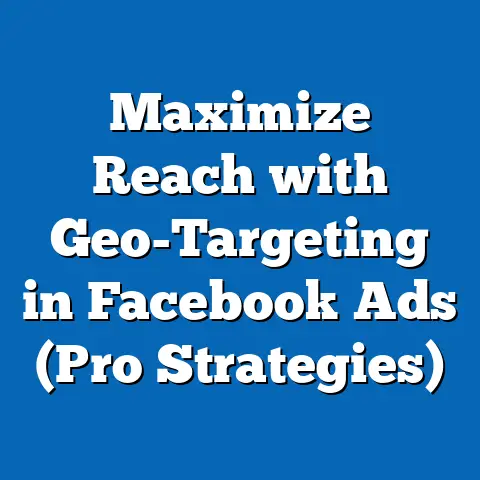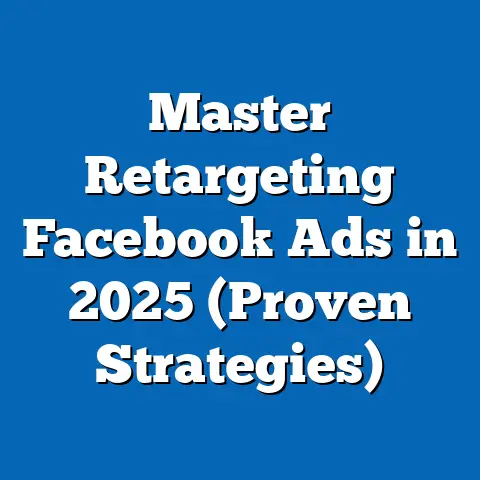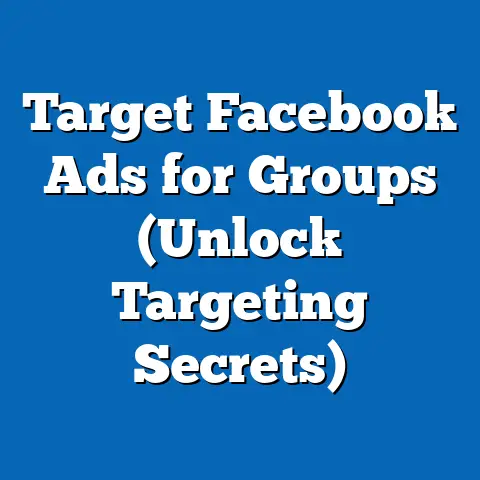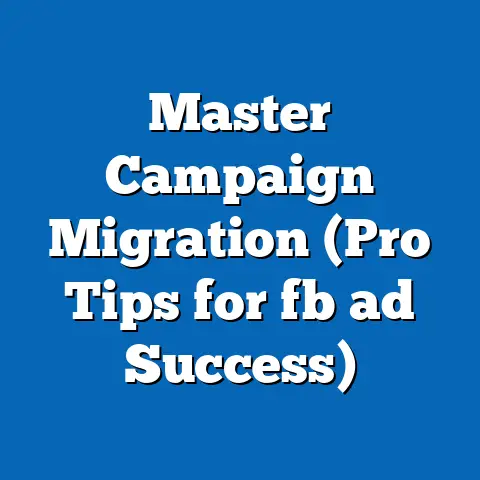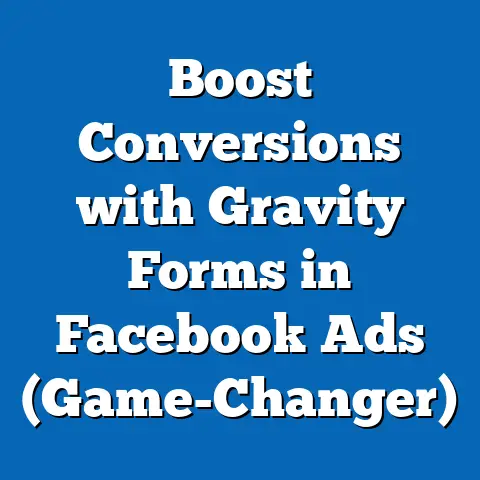Unlock High-Impact Facebook Ads (Proven Design Strategies)
Did you know that 90% of consumers say they find user-generated content more influential than traditional advertising? It’s a statistic that often makes me pause and rethink how I approach ad design. For years, I’ve been immersed in the world of Facebook advertising, and one thing has become abundantly clear: design isn’t just about making things look pretty; it’s about crafting a compelling narrative that resonates with your audience and drives action.
In today’s digital marketing landscape, Facebook ads are an essential tool for businesses of all sizes. With billions of active users, the platform offers unparalleled opportunities to reach specific demographics, interests, and behaviors. However, the sheer volume of ads vying for attention means that yours needs to stand out. A poorly designed ad can be a costly mistake, leading to low engagement, wasted ad spend, and missed opportunities.
That’s where proven design strategies come into play. In this article, I’ll delve into the core elements of high-impact Facebook ad design, from visual hierarchy and color psychology to compelling copywriting and A/B testing. I’ll share real-world examples, case studies, and actionable tips that you can implement to transform your Facebook ads from average to exceptional. My goal is to equip you with the knowledge and tools to create ads that not only capture attention but also drive meaningful results.
Understanding the Facebook Advertising Landscape
The evolution of Facebook ads is a fascinating journey. I remember when Facebook ads were simple text-based messages with a small image. They felt almost like an afterthought. Now, they’re sophisticated, visually rich experiences integrated seamlessly into users’ feeds. This evolution reflects the changing expectations of consumers and the increasing sophistication of Facebook’s advertising platform.
Today, Facebook ads are a crucial component of any comprehensive marketing strategy. They offer unparalleled targeting capabilities, allowing you to reach specific demographics, interests, and behaviors. According to Statista, Facebook’s advertising revenue in 2023 reached over $134 billion, demonstrating the platform’s enduring importance for advertisers.
Let’s break down the different formats available for Facebook ads:
- Image Ads: These are the simplest form of Facebook ads, featuring a single image and accompanying text. They’re great for showcasing products, services, or brand messaging.
- Video Ads: Video ads are highly engaging and can be used to tell stories, demonstrate product features, or share testimonials. They often have higher engagement rates than image ads.
- Carousel Ads: Carousel ads allow you to showcase multiple images or videos in a single ad unit. This format is ideal for highlighting different aspects of a product or service.
- Collection Ads: Collection ads are designed for e-commerce businesses, allowing users to browse and purchase products directly from the ad.
- Instant Experience Ads: Also known as Canvas ads, these are full-screen, mobile-optimized experiences that load instantly when a user clicks on the ad. They offer a highly immersive and interactive way to engage with your audience.
- Lead Ads: Lead ads are designed to capture leads directly within Facebook. They offer a seamless way for users to submit their contact information without leaving the platform.
The power of these formats lies in their ability to be tailored to specific campaign objectives. For example, if you’re trying to drive website traffic, a simple image ad with a clear call-to-action might be sufficient. However, if you’re trying to tell a complex story or showcase multiple products, a video ad or carousel ad might be more effective.
Targeting is another critical aspect of Facebook advertising. With Facebook’s robust targeting options, you can reach highly specific audiences based on demographics, interests, behaviors, and even custom audiences based on your existing customer data. However, even the most precisely targeted ad will fall flat if the design doesn’t resonate with the audience. This is where the art and science of design come into play.
A well-designed ad can significantly influence audience engagement. A visually appealing ad with a clear message is more likely to capture attention, generate clicks, and drive conversions. According to a study by HubSpot, visuals are processed 60,000 times faster in the brain than text. This highlights the importance of using high-quality visuals and designing ads that are visually appealing.
Key Takeaway: Understanding the Facebook advertising landscape, including the different ad formats and the importance of targeting, is crucial for creating high-impact ads. A well-designed ad that resonates with your target audience can significantly improve engagement and drive conversions.
Core Elements of High-Impact Ad Design
The core elements of high-impact ad design are the building blocks that transform a generic ad into a compelling and effective marketing tool. These elements, when combined thoughtfully, can capture attention, communicate your message effectively, and drive action. In my experience, these are the cornerstones of successful Facebook advertising.
Visual Hierarchy
Visual hierarchy is the principle of arranging elements in a way that guides the viewer’s eye and communicates the relative importance of different elements. It’s about creating a clear path for the viewer to follow, ensuring that they see the most important information first.
Think of it like reading a newspaper. The headline is the largest and most prominent element, immediately grabbing your attention and telling you what the story is about. Subheadings break up the text and guide you through the different sections. Images and captions provide visual context and support the story.
In Facebook ad design, visual hierarchy can be achieved through various techniques:
- Size: Larger elements are generally perceived as more important. Use size to emphasize key elements, such as the headline or a product image.
- Color: Contrasting colors can be used to draw attention to specific elements. Use bright colors for important elements and muted colors for less important elements.
- Contrast: High contrast between elements can make them stand out. Use contrast to highlight key elements, such as the call-to-action button.
- Placement: Elements placed in the upper left corner of the ad are generally seen first. Use placement to guide the viewer’s eye and ensure that they see the most important information first.
- Whitespace: Also known as negative space, whitespace is the empty space around elements. It can be used to create visual separation and draw attention to specific elements.
The focal point is the element that immediately grabs the viewer’s attention. It should be the most visually prominent element in the ad and should clearly communicate the main message. In many cases, the focal point is a compelling image or video, but it could also be a bold headline or a striking graphic.
Example: Imagine an ad for a new line of running shoes. The focal point might be a high-quality image of the shoes in action, with a runner sprinting across a scenic landscape. The headline might be “Experience Unprecedented Comfort and Performance.” The call-to-action button might be “Shop Now.”
Key Takeaway: Visual hierarchy is essential for guiding the viewer’s eye and communicating the relative importance of different elements in your ad. By using size, color, contrast, placement, and whitespace effectively, you can create a clear path for the viewer to follow and ensure that they see the most important information first.
Color Psychology
Color psychology is the study of how different colors affect human emotions and behavior. Colors can evoke a wide range of feelings, from excitement and energy to calm and serenity. Understanding color psychology can help you choose colors that resonate with your target audience and support your marketing goals.
Here’s a brief overview of the psychology of different colors:
- Red: Red is associated with excitement, energy, passion, and urgency. It can be used to create a sense of urgency or to draw attention to a call-to-action.
- Blue: Blue is associated with trust, stability, calmness, and professionalism. It’s often used by businesses in the finance, healthcare, and technology industries.
- Green: Green is associated with nature, health, growth, and prosperity. It’s often used by businesses in the environmental, food, and wellness industries.
- Yellow: Yellow is associated with happiness, optimism, energy, and creativity. It can be used to create a sense of fun and excitement.
- Orange: Orange is associated with enthusiasm, warmth, energy, and creativity. It’s often used by businesses in the food, beverage, and entertainment industries.
- Purple: Purple is associated with luxury, sophistication, creativity, and spirituality. It’s often used by businesses in the beauty, fashion, and art industries.
- Black: Black is associated with sophistication, power, elegance, and mystery. It’s often used by luxury brands and businesses that want to convey a sense of exclusivity.
- White: White is associated with purity, cleanliness, simplicity, and innocence. It’s often used to create a sense of space and openness.
Choosing the right color palette for your Facebook ads can significantly impact their performance. Consider your target audience, your brand identity, and the message you want to convey.
Example: A fitness brand might use a combination of red and yellow to create a sense of energy and excitement. A spa might use a combination of blue and green to create a sense of calmness and relaxation.
Key Takeaway: Color psychology is a powerful tool that can be used to evoke specific emotions and influence behavior. By choosing colors that resonate with your target audience and support your marketing goals, you can create Facebook ads that are more effective and engaging.
Typography
Typography is the art and technique of arranging type to make written language legible, readable, and appealing when displayed. It’s about choosing the right fonts, sizes, spacing, and other elements to create a visually harmonious and effective design.
In Facebook ad design, typography plays a crucial role in communicating your message clearly and effectively. The fonts you choose can impact the overall tone and feel of your ad, and the way you arrange the text can impact its readability and legibility.
Here are some best practices for font usage in Facebook ads:
- Choose Readable Fonts: Prioritize readability over style. Choose fonts that are easy to read at a glance, even on small screens.
- Limit the Number of Fonts: Use no more than two or three fonts in your ad. Too many fonts can create a cluttered and confusing design.
- Use Font Hierarchy: Use different font sizes and weights to create a visual hierarchy and guide the viewer’s eye.
- Consider Font Pairing: Choose fonts that complement each other and create a visually harmonious design.
- Pay Attention to Spacing: Use appropriate spacing between letters, words, and lines to improve readability.
- Test Different Fonts: A/B test different fonts to see which ones perform best with your target audience.
Example: A technology company might use a clean, modern font like Helvetica or Arial to convey a sense of professionalism and innovation. A fashion brand might use a more elegant and stylish font like Garamond or Times New Roman to convey a sense of luxury and sophistication.
Key Takeaway: Typography is an essential element of Facebook ad design that can significantly impact its readability, legibility, and overall effectiveness. By choosing the right fonts, sizes, spacing, and other elements, you can create a visually harmonious and effective design that communicates your message clearly and engages your target audience.
Imagery
Imagery, whether in the form of photos or videos, is often the first thing that catches a user’s eye when scrolling through their Facebook feed. It’s the visual hook that can make or break your ad’s performance.
The debate between images and videos in ad performance is ongoing, and the answer often depends on your specific goals and target audience. However, in general, video ads tend to have higher engagement rates than image ads. According to a study by Wyzowl, people share videos twice as much as any other form of content.
However, that doesn’t mean that images are obsolete. High-quality images can be just as effective as videos, especially if they are visually appealing, relevant to your target audience, and clearly communicate your message.
Here are some tips for choosing the right imagery for your Facebook ads:
- Use High-Quality Visuals: Always use high-resolution images and videos that are clear, sharp, and visually appealing.
- Be Relevant to Your Target Audience: Choose images and videos that resonate with your target audience and reflect their interests and values.
- Showcase Your Product or Service: If you’re advertising a product or service, make sure it’s prominently featured in the image or video.
- Tell a Story: Use images and videos to tell a story that engages your audience and connects with them on an emotional level.
- Use Eye-Catching Graphics: Incorporate eye-catching graphics and animations to draw attention to your ad.
- Test Different Visuals: A/B test different images and videos to see which ones perform best with your target audience.
Example: An ad for a travel agency might use a stunning image of a tropical beach to entice users to book a vacation. An ad for a software company might use a short video demonstrating the features of their product.
Key Takeaway: Imagery is a crucial element of Facebook ad design that can significantly impact its performance. By using high-quality visuals that are relevant to your target audience and clearly communicate your message, you can create ads that capture attention, engage users, and drive conversions.
Crafting Compelling Copy
The interplay between ad design and copywriting is crucial for creating high-impact Facebook ads. Design grabs attention, but copy seals the deal. In my experience, a visually stunning ad with weak copy is like a beautiful car with a broken engine – it looks good but doesn’t go anywhere.
Effective copywriting complements the design by providing context, communicating value, and driving action. It’s about crafting headlines and ad copy that are clear, concise, and compelling, and that resonate with your target audience.
Here are some strategies for writing effective headlines and ad copy that complements the design:
- Keep It Short and Sweet: Facebook users are scrolling through their feeds quickly, so you need to capture their attention in a matter of seconds. Keep your headlines and ad copy short and to the point.
- Highlight the Benefits: Focus on the benefits of your product or service, rather than just the features. Tell users how your product or service will make their lives better.
- Use Strong Verbs: Use strong verbs that convey action and excitement. For example, instead of saying “Our product is great,” say “Our product will transform your life.”
- Ask Questions: Asking questions can engage your audience and make them think about their needs and desires.
- Use Numbers and Statistics: Numbers and statistics can add credibility to your claims and make your ad more persuasive.
- Create a Sense of Urgency: Create a sense of urgency by using words like “limited time offer” or “act now.”
- Speak to Your Target Audience: Use language that resonates with your target audience and reflects their interests and values.
The call-to-action (CTA) is the final element of your ad copy, and it’s crucial for driving conversions. The CTA tells users what you want them to do next, whether it’s visiting your website, making a purchase, or signing up for a newsletter.
Here are some tips for writing effective CTAs:
- Be Clear and Concise: Tell users exactly what you want them to do.
- Use Strong Verbs: Use strong verbs that convey action and excitement. For example, instead of saying “Click here,” say “Shop Now” or “Sign Up Today.”
- Create a Sense of Urgency: Create a sense of urgency by using words like “limited time offer” or “act now.”
- Make It Visually Prominent: Make the CTA button visually prominent by using a contrasting color and a clear font.
- Test Different CTAs: A/B test different CTAs to see which ones perform best with your target audience.
Example: An ad for an online course might have the headline “Learn New Skills and Advance Your Career.” The ad copy might highlight the benefits of the course, such as “Gain in-demand skills, boost your resume, and earn a higher salary.” The CTA button might say “Enroll Now.”
Key Takeaway: Compelling copywriting is essential for creating high-impact Facebook ads. By crafting headlines and ad copy that are clear, concise, and compelling, and by using effective CTAs, you can drive action and achieve your marketing goals.
The Role of A/B Testing in Design Strategy
A/B testing, also known as split testing, is a method of comparing two versions of an ad to see which one performs better. It’s a crucial tool for optimizing your ad design and ensuring that you’re getting the most out of your advertising spend.
I’ve seen firsthand how A/B testing can transform a struggling ad campaign into a high-performing one. It’s not about guessing what works; it’s about using data to make informed decisions.
Here’s a step-by-step guide on how to set up A/B tests for different design elements:
- Identify a Variable to Test: Choose a specific design element that you want to test, such as the image, headline, ad copy, or CTA button.
- Create Two Versions of the Ad: Create two versions of the ad that are identical except for the variable you’re testing.
- Set Up the A/B Test in Facebook Ads Manager: In Facebook Ads Manager, create a new campaign and choose the “A/B Test” objective.
- Define Your Target Audience: Define your target audience based on demographics, interests, behaviors, and custom audiences.
- Set Your Budget and Schedule: Set your budget and schedule for the A/B test. It’s important to run the test for a sufficient amount of time to gather enough data to make a statistically significant decision.
- Analyze the Results: Once the A/B test is complete, analyze the results to see which version of the ad performed better. Look at metrics such as click-through rate (CTR), conversion rate, and cost per conversion.
- Implement the Winning Design: Implement the winning design in your ongoing ad campaigns.
You can A/B test a wide range of design elements, including:
- Images: Test different images to see which ones resonate best with your target audience.
- Headlines: Test different headlines to see which ones capture attention and drive clicks.
- Ad Copy: Test different ad copy to see which ones communicate your message most effectively.
- CTA Buttons: Test different CTA buttons to see which ones drive the most conversions.
- Colors: Test different colors to see which ones evoke the desired emotions and influence behavior.
- Layouts: Test different layouts to see which ones are most visually appealing and easy to navigate.
Example: You might A/B test two different images for an ad promoting a new product. One image might feature the product in a studio setting, while the other image might feature the product in a real-world setting. By running an A/B test, you can determine which image performs better with your target audience.
Key Takeaway: A/B testing is a crucial tool for optimizing your ad design and ensuring that you’re getting the most out of your advertising spend. By testing different design elements and analyzing the results, you can make informed decisions about what works best with your target audience.
Case Studies of Successful Facebook Ads
Analyzing real-world examples is one of the best ways to understand how to apply these design principles effectively. I’ve handpicked a few case studies to showcase how brands have leveraged high-impact design to achieve their advertising goals.
Case Study 1: Airbnb
Airbnb is a master of using visually appealing imagery in their Facebook ads. They often feature stunning photos of unique accommodations in exotic locations, instantly capturing the user’s attention. Their copy is concise and focuses on the experience of traveling and exploring new places.
- Design Strategy: High-quality imagery, focus on the travel experience, concise copy.
- What Worked Well: The visually appealing imagery and focus on the travel experience resonated with their target audience, resulting in high engagement rates and increased bookings.
- Lessons Learned: Investing in high-quality imagery is crucial for travel-related businesses. Focus on the experience, not just the product.
Case Study 2: Dollar Shave Club
Dollar Shave Club is known for their humorous and quirky marketing campaigns. Their Facebook ads often feature short, funny videos that showcase their products and brand personality. Their copy is witty and engaging, and their CTAs are clear and concise.
- Design Strategy: Humorous videos, quirky brand personality, witty copy.
- What Worked Well: The humorous videos and quirky brand personality resonated with their target audience, resulting in high engagement rates and increased brand awareness.
- Lessons Learned: Don’t be afraid to be creative and inject humor into your ads. A strong brand personality can help you stand out from the competition.
Case Study 3: Warby Parker
Warby Parker is known for their stylish and affordable eyewear. Their Facebook ads often feature high-quality images of their glasses, showcasing their design and craftsmanship. Their copy is informative and highlights the benefits of their products, such as free home try-ons and affordable prices.
- Design Strategy: High-quality product images, focus on design and craftsmanship, informative copy.
- What Worked Well: The high-quality product images and focus on design and craftsmanship resonated with their target audience, resulting in increased website traffic and sales.
- Lessons Learned: Showcasing your product in a visually appealing way is crucial for e-commerce businesses. Highlight the benefits of your product and make it easy for customers to purchase.
Key Takeaway: These case studies demonstrate the importance of using high-quality visuals, crafting compelling copy, and aligning your ad design with your brand personality and target audience. By learning from these successful campaigns, you can create Facebook ads that are more effective and engaging.
Conclusion
In this article, I’ve explored the core elements of high-impact Facebook ad design, from visual hierarchy and color psychology to compelling copywriting and A/B testing. I’ve shared real-world examples, case studies, and actionable tips that you can implement to transform your Facebook ads from average to exceptional.
Let’s recap the key points:
- Understanding the Facebook advertising landscape is crucial for creating high-impact ads. A well-designed ad that resonates with your target audience can significantly improve engagement and drive conversions.
- Visual hierarchy is essential for guiding the viewer’s eye and communicating the relative importance of different elements in your ad.
- Color psychology is a powerful tool that can be used to evoke specific emotions and influence behavior.
- Typography is an essential element of Facebook ad design that can significantly impact its readability, legibility, and overall effectiveness.
- Imagery is a crucial element of Facebook ad design that can significantly impact its performance.
- Compelling copywriting is essential for creating high-impact Facebook ads.
- A/B testing is a crucial tool for optimizing your ad design and ensuring that you’re getting the most out of your advertising spend.
The world of Facebook advertising is constantly evolving, but the principles of good design remain timeless. By integrating these proven design strategies into your Facebook ads, you can unlock their full potential and achieve your marketing goals.
Are your Facebook ads truly capturing attention and driving results, or are they getting lost in the noise? Take a moment to evaluate your own ad designs and identify areas for improvement. By implementing the strategies discussed in this article, you can transform your Facebook ads into powerful marketing tools that drive engagement, conversions, and ultimately, business success.

